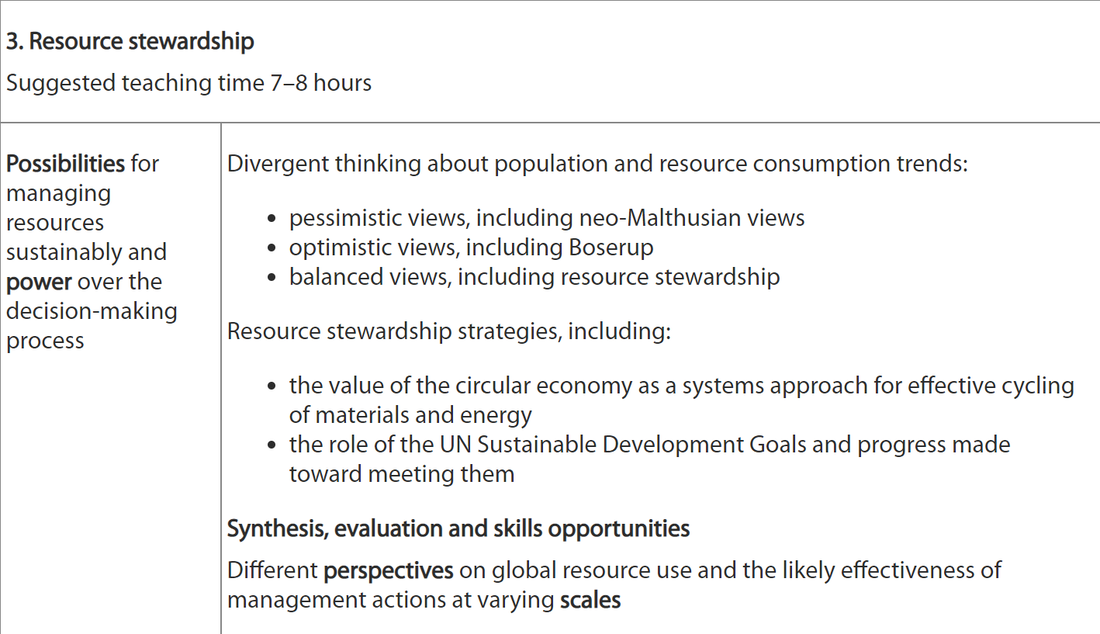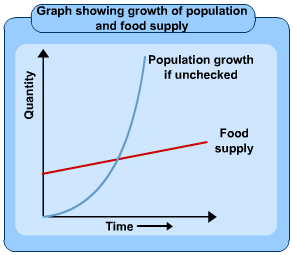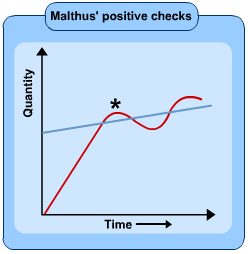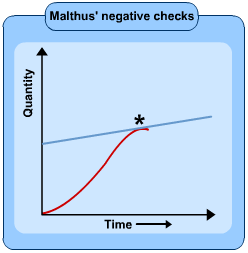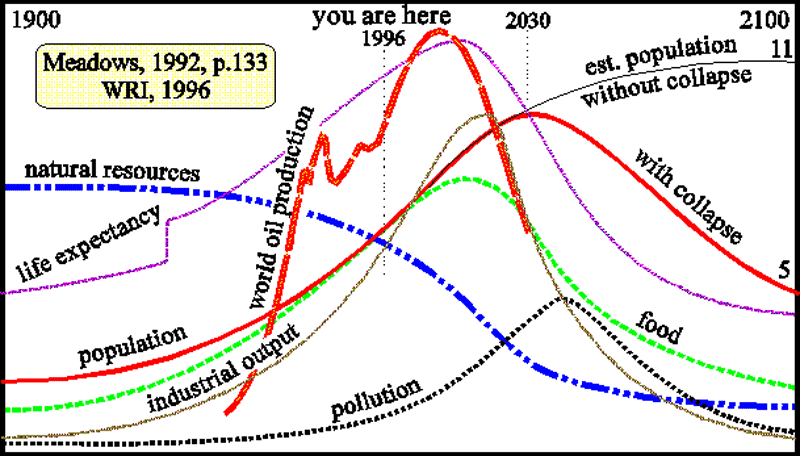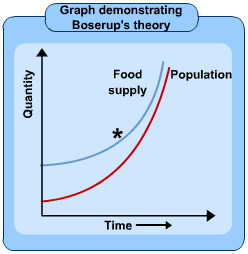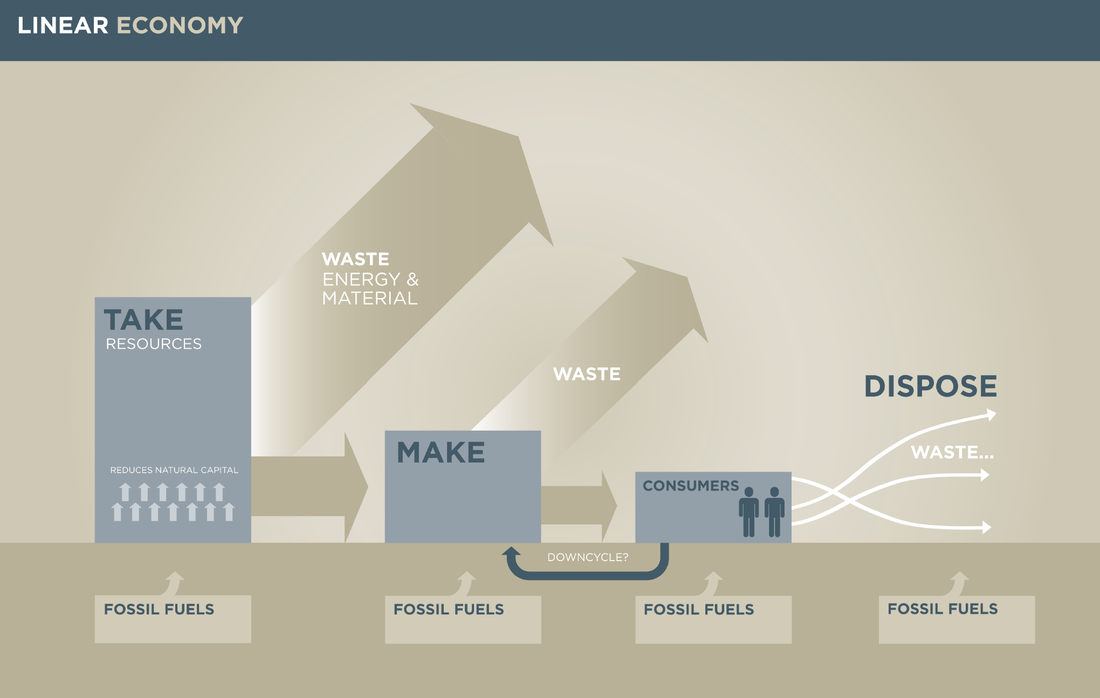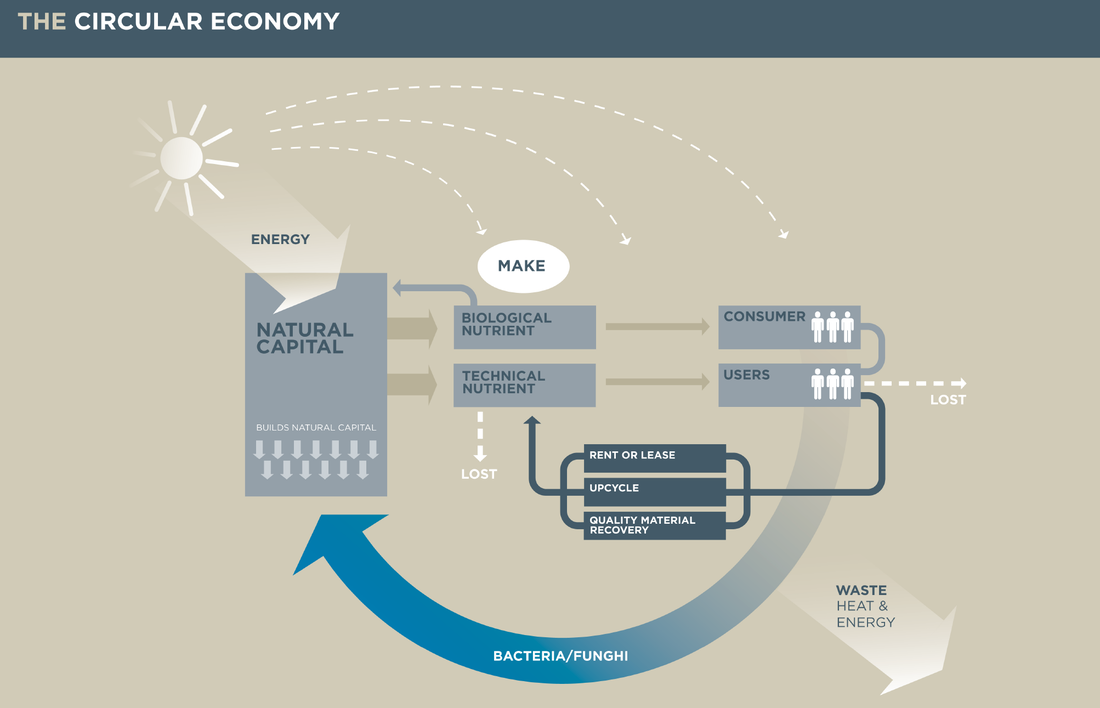Pessimistic: Neo-Malthusian Views
|
Population and Food Supply
Thomas Malthus theorized that populations grew in geometric progression. A geometric progression is a sequence of numbers where each term after the first is found by multiplying the previous one by a fixed, non-zero number called the common ratio. For example, in the sequence 2, 10, 50, 250, 1250, the common ratio is 5. Additionally, he stated that food production increases in arithmetic progression. An arithmetic progression is a sequence of numbers such that the difference between the consecutive terms is constant. For example, in the sequence 2, 5, 8, 11, 14, 17, the common difference of 3. He derived this conclusion due to the Law of Diminishing Returns. From this, we can conclude that populations will grow faster than the supply of food. This will lead to a shortage of food. |
|
Population Control
Malthus then argued that because there will be higher population than the availability of food, many people will die from the shortage of food. He theorized that this correction will take place in the form of Positive Checks (or Natural Checks) and Preventative Checks. These checks would lead to the Malthusian catastrophe, which would bring the population level back to a ‘sustainable level’. Positive Checks or Natural Checks . Positive checks exercise their influence on the growth of population by increasing the death rate. They are applied by nature. The positive checks to population are various and include every cause, whether arising from vice or misery, which in any degree contributes to shorten the natural duration of human life. The unwholesome occupations, hard labour, exposure to the seasons, extreme poverty, bad nursing of children, common diseases, wars, plagues and famines ire some of the examples of positive checks. They all shorten human life and increase the death rate. Malthus recommended the use of preventive checks if mankind was to escape from the impending misery. If preventive checks were not effectively used, positive checks like diseases, wars and famines would come into operation. As a result, the population would be reduced to the level which can be sustained by the available quantity of food supply. |
|
Negative or Preventative Checks
To correct the imbalance, Malthus also suggested using preventative measures to control the growth of the population. Preventive checks exercise their influence on the growth of population by bringing down the birth rate. Preventive checks are those checks which are applied by man. Preventive checks arise from man’s fore-sight which enables him to see distant consequences He sees the distress which frequently visits those who have large families. He thinks that with a large number of children, the standard of living of the family is bound to be lowered. He may think that if he has to support a large family, he will have to subject himself to greater hardships and more strenuous labour than that in his present state. He may not be able to give proper education to his children if they are more in number. Further, he may not like exposing his children to poverty or charity by his inability to provide for them. These considerations may force man to limit his family. Late marriage and self-restraint during married life are the examples of preventive checks applied by man to limit the family. |
A group known as the Club of Rome headed by Dennis Meadows wrote The Limits to Growth, in which the authors argued that the combination of population growth and finite natural resources would create mass misery (figure 9.3). The group ran several computer simulations on the future of humanity under various scenarios, all of which seemed to end in disaster, often around 2015. At the time, computer simulations were seen as innovative and futuristic, and the model gained credibility simply because it used a computer to generate the output. Even the basic computer-generated output with its hand-drawn overlay was considered impressively ground-breaking in the early 1970s.
Codrington, Stephen. Our Changing Planet (Planet Geography Book 1) . Solid Star Press. Kindle Edition.
Codrington, Stephen. Our Changing Planet (Planet Geography Book 1) . Solid Star Press. Kindle Edition.
|
Criticism of Malthusian Theory
(i) It is pointed out that Malthus’s pessimistic conclusions have not been borne out by the history of Western European countries. Gloomy forecast made by Malthus about the economic conditions of future generations of mankind has been falsified in the Western world. Population has not increased as rapidly as predicted by Malthus; on the other hand, production has increased tremendously because of the rapid advances in technology. As a result, living standards of the people have risen instead of falling as was predicted by Malthus. (ii) Malthus asserted that food production would not keep pace with population growth owing to the operation of the law of diminishing returns in agriculture. But by making rapid advances in technology and accumulating capital in larger quantity, advanced countries have been able to postpone the stage of diminishing returns. By making use of fertilizers, pesticide better seeds, tractors and other agricultural machinery, they have been able to increase their production greatly. In fact, in most of the advanced countries the rate of increase of food production has been much greater than the rate of population growth. Even in India now, thanks to the Green Revolution, the increase in food production is greater than the increase in population. Thus, inventions and improvements in the methods of production have belied the gloomy forecast of Malthus by holding the law of diminishing returns in check almost indefinitely. (iii) Malthus compared the population growth with the increase in food production alone. Malthus held that because land was available in limited quantity, food production could not rise faster than population. But he should have considered all types of production in considering the question of optimum size of population. England did feel the shortage of land and food. If England had been forced to support her population entirely from her own soil, there can be little doubt that England would have experienced a series of famines by which her growth of population would have been checked.But England did not experience such a disaster. It is because England industrialized itself by developing her natural resources other than land like coal and iron, and accumulating man-made capital equipment like factories, tools, machinery, mines, ships and railways, this enabled her to produce plenty of industrial and manufacturing goods which she then exported in exchange for food-stuffs from foreign countries. There is no food problem in Great Britain. Therefore, Malthus made a mistake in taking agricultural land and food production alone into account when discussing the population question. As already said, he should have rather considered all types of production. (iv) Malthus held that the increase in the means of subsistence or food supplies would cause population to grow rapidly so that ultimately means of subsistence or food supply would be in level with population, and everyone would get only bare minimum subsistence. In other words, according to Malthus, living standards of the people cannot rise in the long run above the level of minimum subsistence. But, as already pointed out, living standards of the people in the Western world have risen greatly and stand much above the minimum subsistence level. There is no evidence of birth-rate rising with the increases in the standard of living. Instead, there is evidence that birth-rates fall as the economy grows. In Western countries, attitude towards children changed as they developed economically. Parents began to feel that it was their duty to do as much as they could for each child. Therefore, they preferred not to have more children than they could attend to properly. People now began to care more for maintaining a higher standard of living rather than for bearing more children. The wide use of contraceptives in the Western world brought down the birth rates. This change in the attitude towards children and the wide use of contraceptives in the Western world has falsified Malthusian doctrine. (v) Malthus gave no proof of his assertion that population increased exactly in geometric progression and food production increased exactly in arithmetic progression. It has been rightly pointed out that population and food supply do not change in accordance with these mathematical series. Growth of population and food supply cannot be expected to show the precision or accuracy of such series. However, Malthus, in later editions of his book, did not insist on these mathematical terms and only held that there was an inherent tendency in population to outrun the means of subsistence. We have seen above that even this is far from true. |
|
Optimistic Views: Boserup
|
Ester Boserup (1910–1999) was a Danish economist who specialised in the economics and development of agriculture. She worked for the United Nations and her experience working in low- and middle-income countries such as India helped to shape her theory of the relationship between human population growth and food production.
In her work ‘The Conditions of Agricultural Growth: The economics of agrarian change under population pressure’ (1965), Boserup challenged Malthus’s conclusion that the size of the human population is limited by the amount of food it can produce. She suggested that food production can, and will, increase to match the needs of the population. Drawing on her knowledge of farming in the developing world, where populations were growing quickly, Boserup argued that the threat of starvation and the challenge of feeding more mouths motivates people to improve their farming methods and invent new technologies in order to produce more food. Boserup described this change as ‘agricultural intensification’. For example, a farmer who has four fields to produce food for his family might grow crops in three of the fields, but leave the fourth field empty as the ground is dry and his crop will not grow there. However if the farmer has two more children, the pressure to produce more food might drive him to build irrigation canals to bring water to the fourth field or to buy a different type of seed that will grow in drier ground. He would change the way he farms to make sure that he has enough food to support a larger family. |
Criticism of Boserup:
1. The major criticism levelled against Boserup theory is that it is not applicable to those economies where the urban industrial sector is less developed, The U.S. A. or Canadian economies even, if it is sparsely populated as compared to many other economies is, thus, no longer a test case for this theory.
2. Boserup has expressed the hope that in the present day underdeveloped economies, growing population can be absorbed in the agricultural sector. But, this idea is true in countries like U.S.A. where the density of population is quite low. The farm problem in such economies has necessitated transfer of labour from agriculture sector to the non-agriculture sector.
The reason is that it is difficult to understand Boserup’s opinion how urbanisation and subsequent industrialization took place in such countries when pressure of population on agricultural development was quite low in pre- urbanisation periods. In fact, there are certain other significant factors which are quite important to bring urbanisation and industrialization in those countries.
3. Though, Boserup has attempted to show that cultivation becomes more intensive when population increases and becomes extensive in character when population falls. But, this assertion of Boserup is not fully convincing. It is due to the reason that the sequence of intensification of cultivation and accompanying technical, institutional and social set up enumerated by her is not fully reversible.
In Indian context, the growing unemployment in the agricultural sector in the post-independence period is so conspicuous that it can be ignored. In other words, disguised unemployment in traditional agricultural economies of South East Asia fails to recognise the fact that agricultural development has totally failed to absorb growing population.
4. Boserup has absolutely ignored the unfavourable effects of growing population on agriculture. In backward economies where land frontiers have already been reached, the sub-division and fragmentation of holdings must follow. Thus, small farmers in turn will obstruct the use of improved technology and the growing population may adversely affect the process of capital formation.
1. The major criticism levelled against Boserup theory is that it is not applicable to those economies where the urban industrial sector is less developed, The U.S. A. or Canadian economies even, if it is sparsely populated as compared to many other economies is, thus, no longer a test case for this theory.
2. Boserup has expressed the hope that in the present day underdeveloped economies, growing population can be absorbed in the agricultural sector. But, this idea is true in countries like U.S.A. where the density of population is quite low. The farm problem in such economies has necessitated transfer of labour from agriculture sector to the non-agriculture sector.
The reason is that it is difficult to understand Boserup’s opinion how urbanisation and subsequent industrialization took place in such countries when pressure of population on agricultural development was quite low in pre- urbanisation periods. In fact, there are certain other significant factors which are quite important to bring urbanisation and industrialization in those countries.
3. Though, Boserup has attempted to show that cultivation becomes more intensive when population increases and becomes extensive in character when population falls. But, this assertion of Boserup is not fully convincing. It is due to the reason that the sequence of intensification of cultivation and accompanying technical, institutional and social set up enumerated by her is not fully reversible.
In Indian context, the growing unemployment in the agricultural sector in the post-independence period is so conspicuous that it can be ignored. In other words, disguised unemployment in traditional agricultural economies of South East Asia fails to recognise the fact that agricultural development has totally failed to absorb growing population.
4. Boserup has absolutely ignored the unfavourable effects of growing population on agriculture. In backward economies where land frontiers have already been reached, the sub-division and fragmentation of holdings must follow. Thus, small farmers in turn will obstruct the use of improved technology and the growing population may adversely affect the process of capital formation.
- According to Malthusians and neo-Malthusians, how does population growth affect resource availability and consumption?
- Describe the message presented by the Club of Rome in 1972. In your answer, refer to the Club of Rome’s model.
- In what ways do anti-natalist population policies reflect a neo-Malthusian viewpoint?
- Explain the differences between Ester Boserup’s and Thomas Malthus’ views on the relationship between population growth and food supply.
- Describe the process of agricultural intensification that was identified by Ester Boserup.
- What is the relationship between the scarcity of a resource and its price?
- Describe the long-term trend of commodity prices. What does this suggest about the scarcity of those commodities?
Balanced View: Resource Stewardship
The balanced views have been suggested as a strategies for sustainably managing natural resources. This involves using conserving and preservation of natural resources whilst depending on human ingenuity or technological advances to find sustainable solutions to resource management.
On the other side of the spectrum, improved governance of natural resources could also lead to sustainable management of existing resources. This could involve:
Conservation: refers to the process of protecting and managing a resource in such a way that it will not be degraded or damaged. This can be done through a reducing the use of the resource e.g forest resources can be protected against irresponsible lumbering or by encouraging afforestation. In terms of energy conservation, existing energy resources can be used in such a way that future generations can benefit from it, resulting in little or no environmental damage.
Preservation: attempts to maintain resources in their present condition in areas untouched by humans. This emanates from the fact that mankind is encroaching on the natural environment in an unprecedented manner; a rate at which many unprotected landscapes are being exploited for agriculture, industry, housing, tourism and other human developments.
"Stewardship is the ethical principle that views managing resources as a responsibility undertaken as a privilege on behalf of others. In other words, resources are managed with the needs of the wider (and even global) community in mind, taking into account resource availability for future generations. Stewardship is thus quite different to exploiting resources for immediate profit as a avaricious owner might do. Resource stewardship encourages a sustainable and responsible approach to managing resources that looks towards the needs of future generations rather than seeking immediate, short-term outcomes."
Codrington, Stephen. Our Changing Planet (Planet Geography Book 1) . Solid Star Press. Kindle Edition.
On the other side of the spectrum, improved governance of natural resources could also lead to sustainable management of existing resources. This could involve:
- The is the need for international organizations, governments, as well as financial institutions such as the World Bank and the International Monetary Fund, to ensure that individuals, businesses and organizations do more, as stewards of natural resources, to promote conservation and preservation principles. Hence, the balanced approach is a combination of resource conservation and resource preservation strategies (Oakes, 2018).
- The could also be policies that ensure fairness and equity in the distribution of resources at the global scale. Food, for instance, should be made cheaply available to people in developing countries, where population is rapidly increasing.
Conservation: refers to the process of protecting and managing a resource in such a way that it will not be degraded or damaged. This can be done through a reducing the use of the resource e.g forest resources can be protected against irresponsible lumbering or by encouraging afforestation. In terms of energy conservation, existing energy resources can be used in such a way that future generations can benefit from it, resulting in little or no environmental damage.
Preservation: attempts to maintain resources in their present condition in areas untouched by humans. This emanates from the fact that mankind is encroaching on the natural environment in an unprecedented manner; a rate at which many unprotected landscapes are being exploited for agriculture, industry, housing, tourism and other human developments.
"Stewardship is the ethical principle that views managing resources as a responsibility undertaken as a privilege on behalf of others. In other words, resources are managed with the needs of the wider (and even global) community in mind, taking into account resource availability for future generations. Stewardship is thus quite different to exploiting resources for immediate profit as a avaricious owner might do. Resource stewardship encourages a sustainable and responsible approach to managing resources that looks towards the needs of future generations rather than seeking immediate, short-term outcomes."
Codrington, Stephen. Our Changing Planet (Planet Geography Book 1) . Solid Star Press. Kindle Edition.
The Circular Economy
|
|
|
|
The Circular economy
Looking beyond the current take-make-dispose extractive industrial model, a circular economy aims to redefine growth, focusing on positive society-wide benefits. It entails gradually decoupling economic activity from the consumption of finite resources, and designing waste out of the system. Underpinned by a transition to renewable energy sources, the circular model builds economic, natural, and social capital. It is based on three principles:
In a circular economy, economic activity builds and rebuilds overall system health. The concept recognises the importance of the economy needing to work effectively at all scales – for large and small businesses, for organisations and individuals, globally and locally.
Transitioning to a circular economy does not only amount to adjustments aimed at reducing the negative impacts of the linear economy. Rather, it represents a systemic shift that builds long-term resilience, generates business and economic opportunities, and provides environmental and societal benefits.
Differences between linear and circular systems
This system is different from the linear systems approach, where (eco-efficiency). Sustainability, in the circular systems approach, focuses n minimizing the negative impact of the system and maximizing the positive impact through innovations and systems change (eco-effectiveness).
The linear economy works on the ‘take-make-dispose’ plan but the circular economy operates on the principles of reduce-reuse-recycle.
Looking beyond the current take-make-dispose extractive industrial model, a circular economy aims to redefine growth, focusing on positive society-wide benefits. It entails gradually decoupling economic activity from the consumption of finite resources, and designing waste out of the system. Underpinned by a transition to renewable energy sources, the circular model builds economic, natural, and social capital. It is based on three principles:
- Design out waste and pollution
- Keep products and materials in use
- Regenerate natural systems
In a circular economy, economic activity builds and rebuilds overall system health. The concept recognises the importance of the economy needing to work effectively at all scales – for large and small businesses, for organisations and individuals, globally and locally.
Transitioning to a circular economy does not only amount to adjustments aimed at reducing the negative impacts of the linear economy. Rather, it represents a systemic shift that builds long-term resilience, generates business and economic opportunities, and provides environmental and societal benefits.
Differences between linear and circular systems
This system is different from the linear systems approach, where (eco-efficiency). Sustainability, in the circular systems approach, focuses n minimizing the negative impact of the system and maximizing the positive impact through innovations and systems change (eco-effectiveness).
The linear economy works on the ‘take-make-dispose’ plan but the circular economy operates on the principles of reduce-reuse-recycle.
Your browser does not support viewing this document. Click here to download the document.
| Short introduction to the Circular economy | |
| File Size: | 1677 kb |
| File Type: | |
